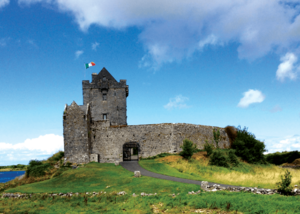Peter Martyn (judge) facts for kids

Peter Martyn (born after 1630, died after 1690) was an Irish lawyer, landowner, and judge. He was one of the Roman Catholic judges chosen for the Irish legal system by King James II. This was part of King James's plan to have only Catholic officials in Ireland. After King James lost power at the Battle of the Boyne, Peter Martyn was accused of trying to join the new government. However, he was soon declared a traitor. He later had to leave the country and died while living in another land.
Early Life and Family
Peter Martyn was born in Kinvara, a town in County Galway, Ireland. He was the second son of Richard Óge Martyn (who died in 1648) and Magdalen French. His family lived at Dunguaire Castle. Peter's father, Richard, was a rich landowner, lawyer, and politician.
Richard Óge Martyn and his cousin, Patrick D'Arcy, were Catholic lawyers in County Galway. They kept practicing law in the 1630s, even though laws called the Penal Laws tried to stop Catholics from working in many professions. Eventually, the King's government stopped them. Richard was also an important person in Confederate Ireland, a Catholic government that ruled much of Ireland during the 1640s.
Peter's older brother, Oliver Óge Martyn, was able to keep the family's lands. Even though their father had been seen as disloyal to the King, Oliver was never declared a traitor. People in his community thought highly of him.
Becoming a Judge
After King Charles II returned to the throne, there was more religious toleration in Ireland. Both King Charles and his brother, James, who would become the next king, were known to favor the Catholic faith. Because of this, Peter's cousin, Patrick D'Arcy, could go back to practicing law. He might have encouraged Peter to become a lawyer too.
Peter Martyn studied law at Middle Temple in London starting in 1663, and then at the King's Inn in Dublin in 1673. By 1683, he was working as a lawyer in the Connaught region of Ireland. He became quite wealthy and bought a large estate called Kilconnel in County Galway.
When King James II became King in 1685, he didn't immediately replace the Protestant judges in Ireland. But by 1687, he decided to appoint Catholics to important positions. Even though Peter Martyn had only been a lawyer for 14 years, his wealth and social standing likely made him a good choice for a judge. He was appointed as the third judge of the Court of Common Pleas (Ireland), which handled legal disputes. He regularly traveled around the Connaught region as a judge.
Later Life and Exile
After King James lost power at the Battle of the Boyne, Peter Martyn, like many other judges, tried to work with the new King, William III. It seems he offered his help to the new government. Some people who supported King James even called him "a civil governor in the enemy's quarter," meaning he was trying to be friendly with the new side.
His brother Oliver had been pardoned for supporting King James, which might have given Peter hope for similar treatment. However, this didn't happen. Peter Martyn was declared a traitor, and his estate at Kilconnel was taken away. He and his family had to leave Ireland and live in another country. The exact date of his death is not known.
An author named Burke wrote in 1885 that Peter Martyn was a "great humorist" and that many stories were still told about him. However, Burke didn't share any of those stories.
Images for kids
-
Dunguaire Castle, Peter Martyn's birthplace


